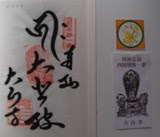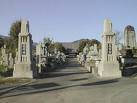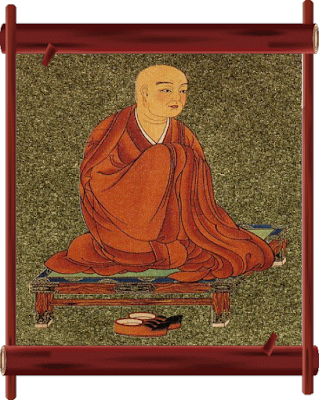:::::::::::::::::::::::::::::::::::::::::::::::::::::::::::::::::::::::::::::::::::::::::::::::::::::
Fudo Myo-O at temple Daigoji 醍醐寺 Daigo-Ji

PHOTO : www.kah-bonn.de, 2008
Seated Fudō Myōō
Kaikei, Kamakura period, 1203 (Kennin 3)
Polychrome wood
Exhibition
Temple Treasures of a Sacred Mountain Daigo-ji -
The Secret Buddhism in Japan
25 April to 24 August 2008, Bonn Germany
Shingon Buddhism
The exhibition is an introduction to Shingon Buddhism and presents the Daigo-ji temple as a key cultural heritage site. It demonstrates the way in which religion reverberates through art and history. The unfamiliar pictorial language that characterises much of Esoteric or Secret Buddhism is examined in the context of its religious teachings in order to elucidate the roots of its symbolism and its ritual significance.
The art of Shingon Buddhism often seems confusing because of the large number of Buddhas and the unusual forms they take. By focusing on those figures of the pantheon that are relevant in the context of the Daigo-ji temple, the exhibition provides an insight into the basic structure of Shingon imagery.
© www.kah-bonn.de, 2008
:::::::::::::::::::::::::::::::::::::::::::::::::::::::::::::::::::::::::::::::::::::::::::::::::::::
醍醐寺 不動明王

In 874, a Buddhist monk Shobo, who is known under his posthumous name of Rigen Daishi (the Great Master of Holy Treasures), built a hermitage to which Kannon (Avalokitesvara) statues of Juntei and Nyoirin were dedicated on the top of the Kamidaigo mountain where he discovered a well of the spiritual water named Daigo through an inspiration from a local god Yokoo Daimyojin. This is the origin of Daigoji temple. After a while pious supports of Emperor Daigo (897-930), Suzaku (930-46), and Murakami (946-67) contributed to development of Daigoji temple complex.
In 907, for instance, the Yakushi hall was constructed to fulfill the imperial wish of Emperor Daigo. The temple complex of Kamidaigo (the upper part of Daigo) was completed by construction of the Godai hall. Consequently a plan of the Shimodaigo (the lower part of Daigo) complex was carried on. The Sakyamuni hall built in 926 and the five-storied pagoda built in 951 were consisted of the prototype of the Shimodaigo temple complex.
Since then Daigoji has played an important role as a main temple of Shingon school Ono branch in a history of Japanese Buddhism. Moreover, it might be worthwhile to note that many politicians in power have had a close family relationship with this temple. For instance, the linage of Minamoto Toshifusa, called Daigo Minamoto family, were the heads of this temple for many generations. Minamoto Toshifusa is known for having seized power instead of Fujiwara family in the late Heian period.
When his son Shokaku was the head of the temple, the temple complex of both Kamidaigo and Shimodaigo was more developed and the Sanboin was constructed in 1115. From his time on Daigoji temple had enjoyed its prosperity. However, Daigoji temple suffered from several fires. The fire especially caused by Onin and Bunmei wars in Kyoto city destroyed the Shimodaigo complex except the five-storied pagoda. It is fortunate that nowadays we can see the pagoda built in 951. In Kamidaigo complex the Juntei hall is well known as the eleventh place of the pilgrimage in the Western part of Japan and the Godai hall is as the center of the Godai-san faith.
The treasures in Daigoji which amount to more than a hundred thousand are preserved in Reihokan. Some of them are exhibited to the public in spring and autumn.
Hanami Parade.
On the secound Sunday of April
In the spring of 1598 Toyotomi Hideyoshi organized a gorgeous Hanami (Cherry-blossom viewing) party. Participants of the party amounted about 900, in which Hideyoshi's wife Kitanomandokoro, his son Hideyori, Hideyori's mother Yodo, several Daimyos and Shomyos, and so on, were included. This can be regarded as the last splendour of the person in power, for Hideyoshi died at the same year.
Read more here on the English HP of Temple Daigoji
© www.daigoji.or.jp

Fudo Waterfall at Temple Daigo-Ji
- quote -
Daigo-Sui 醍醐水 Daigosui water
Sweet Taste of Spring Water
Daigoji Temple in Fushimi Ward, Kyoto, is now selling "Daigo-Sui," or Daigo spring water, which is bottled groundwater pumped from a well in the temple's precincts.

Daigoji Temple has a legend that Rigen-daishi, the temple's founder, was moved to say, "This is really delicious." after drinking the water of a spring in the mountains, and resolved to spread Buddhism. In 2009, the bottles were first given away as commemorative gifts for invited guests who attended the memorial service of the 1,100th anniversary of Rigen-daishi's death, and gained popularity. As a result, the temple decided to make them available commercially.
"Daigo-sui" is soft water that has passed Kyoto City water quality inspection. A 300-milliliter bottle costs 200 yen, and can be bought at the shop in the precincts or by mail order. The water intake from the well is limited at up to 5,000 or 10,000 bottles per month.
- source : kyoto-np.jp/kp/topics/eng -
:::::::::::::::::::::::::::::::::::::::::::::::::::::::::::::::::::::::::::::::::::::::::::::::::::::::

Guide to Kami-Daigo(the upper part of Daigo)
Guide to Shimo-Daigo (the lower part of Daigo)
Guide to Sanboin
Fudodo, Goma-dojo
Five statues of Myo-o (Vidyaraja), with Fudo Myo-o (Acalanatha) in the center, are enshrined in Fudodo Hall. At Goma-dojo in front of Fudodo, the Saitogoma ceremony is performed by Tozan-ha mission practitioners of Shugen-do to pray for various concerns including world peace.

- source : www.daigoji.or.jp
:::::::::::::::::::::::::::::::::::::::::::::::::::::::::::::::::::::::::::::::::::::::::::::::::::::::::::::::::::::::::::
紙本墨画不動明王像 altogether 5 paintings

不動明王像(三幅) 信海筆
Shinkai, painter of the Kamakura period

不動明王像(三幅)鳥羽僧正様
Toba Soojoo 鳥羽僧正 Toba Sojo
Look at one more scroll here
不動明王像(三幅))長賀筆
Chooga 長賀 Choga - 宅磨長賀 Takuma Choga, painter of the Kamakura period
- source : daigoji.or.jp/archives
. banjakuza, iwaza, ganza 盤石座, 岩座
stone pedestal for Fudo .
:::::::::::::::::::::::::::::::::::::::::::::::::::::::::::::::::::::::::::::::::::::::::::::::::::::::
The bent Fudo .. Yojiri Fudo . よぢり不動
by Buddhist Painter Yoshihide 絵仏師良秀

© PHOTO : www2.kokugakuin.ac.jp
(醍醐寺蔵 良秀様 不動明王図像)
The painter of this work ran out of his burning home to look at the flames, leaving wife and child to perish, but he painted the flames of Fudo !
The painting is in the store of Daigo-Ji.
............................ I found the story here also:
Long, long ago there lived an old artist in a town. His specialty was to paint images of Buddha; especially Fudo Myo-o---the Buddhist Divinity of Fire.
One day he was painting as usual. He concentrated his attention on his work. The Buddha he was working on was almost finished, but he wasn't satisfied with it. He sat at the picture all day, took a look at it, and added a blush or two, and took another look, one more blush was added...
It was windy that night. Suddenly a fire broke out from the neighboring house.
"Fire! Fire!" his wife panicked and cried.
But the artist was still gazing at his picture with a frown and arms crossed. Soon the fire started attacking his house. The smoke came into his room with the sounds of burning. No time to escape! His wife pulled his sleeve desperately, and cried frantically,
"Get out, or you'll be burned to death!"
The husband said to her calmly,
"Wait! I have to finish this work." He brushed her hand aside and kept on staring at the picture. Then there was a big sound! Part of the roofs was burned to the ground.
"Wow," the wife jumped out of the room in a hurry.
The flame caught his picture. The artist came to himself and rushed out of the burning house. He had a very narrow escape from the fire. Then he stood on the other side of the street to watch his house burning. An hour later, it burned down completely.
"We feel great sorrow for you." the neighbors consoled him for his bad luck.
"......." he didn't answer them, but kept looking at the ruins.
People came to him one after another to express their sympathy, but he said nothing. It looked like he had been meditating. His wife was worried about him and spoke to him nervously,
"What happened to you? Are you all right?"
He babbled something to her and smiled. Seeing him, many people there thought that he had gone mad because he had lost his house.
His wife asked him again,
"Are you all right?"
Then he said to her rather clearly,
"I've kept painting for many years. But I was never completely satisfied with my work. Thanks to this fire, I've learned something important. It was a wonderful experience for me."
Somehow he looked happy. People around him calmly listened to him.
"As you know I've painted images of Buddha with flames on his back. Now I should say the way I painted the flames was wrong. I've just learned how to paint the flames for the first time in my life. That's an eye opener for me. I can't wait to paint a new image of Buddha. This experience will add a new perspective into my picture."
Fudo Myo-o---its appearance is impressive, the angry face is scared. But inside the Buddha is full of love to people who are agonizing. The Buddha tries to give them a hand with a sword in its right hand, a rope in his left hand. The flames on his back show they will burn people's 108 worldly desires.
The images of Fudo Myo-o he painted from then on drew people's attention. They said his images seemed to sit in the real burning flames to save people. They wanted to have one since just looking at the images, they felt relieved. Soon he made enough money to rebuild a bigger house.
The Buddha painter Yoshihide was ranked among the most gifted artists at that time.
© (2007.6.1 With Itaya)
:::::::::::::::::::::::::::::::::::::::::::::::::::::::::::::::::::::::::::::::::::::::::::::::::::
From the Daruma Museum
Seiryuu Gongen at temple Daigo-Ji 清瀧権現, 醍醐寺
Clear Dragon Deity
Godairiki-San 五大力さん
At temple Daigo-Ji 醍醐寺
February 23.
This festival is a type of the Ninnoo-e 仁王会(にんのうえ) ritual, performed at the temple Daigoji. It shows elements of the rituals for the five gread Fudo godai myo-o 五大明王.
. "Godairiki-san" or
Festival of the Five Powerful Deities .

source : facebook
Poster at Kyoto Station in 2014
. Godai Myo-O 五大明王 Five Great Myo-O
Godai-son 五大尊 Five Great Wisdom Kings .
:::::::::::::::::::::::::::::::::::::::::::::::::::::::::::::::::::::::::::::::::::::::::::::::::::::::
Kukai was a friend of Saicho and traveled to China in 802, the same year Saicho did.
?? Kukai Kobo Daishi and Saicho both stayed at Daigo-Ji for some time, but then took separate ways to establish their own sects, Shingon and Tendai.
A stone statue of Fudo Myo-O from the temple, said to be carved by Kukai himself, was brought to the Kanto area to bring peace to the region and marks the beginning of Narita Fudo in Chiba.
. Narita Fudo 成田不動尊 .
新勝寺 Temple Shinsho-Ji, Chiba
:::::::::::::::::::::::::::::::::::::::::::::::::::::::::::::::::::::::::::::::::::::::::::::::::::::
daigomi 醍醐味 "taste of Daigo"
- quote -
Daigo (dairy product)
Daigo was a type of dairy product made in Japan during the 10th century.
The first mention of this word was in Nirvana Sutra.
譬如從牛出乳 從乳出酪 從酪出生蘇 從生蘇出熟蘇 從熟蘇出醍醐 醍醐最上
— 『大般涅槃経』
From cows to fresh milk;
fresh milk to cream;
cream to curdled milk;
curdled milk to butter;
butter to ghee (daigo).
Daigo is the best.
- Nirvana Sutra
This is the origin of the word, daigo-mi (醍醐味), which means a superb flavor.
Emperor Daigo encouraged the production of so and other cheese-like products. His name origin is thought to be based on the above text. Daigo is thought to have come from China, but it is no longer made in either China or Japan.
- source : wikipedia -

醍醐味もさすがに土佐の船料理
daigomi mo sasuga ni Tosa no funaryoori
such delicious taste !
yes indeed this is
the food on board in Tosa
Iino san 飯野鳴潮
. WASHOKU - Food from Kochi / Tosa .
. so そ 蘇(そ)酥 / 蘇 milk products of old .
Nara
daigo 醍醐 is the fifth of our five tasts (gomi 五味).
It symbolizes something very much at the top, in Buddhism even satori or enlightenment.
:::::::::::::::::::::::::::::::::::::::::::::::::::::::::::::::::::::::::::::::::::::::::::::::::::::
[ . BACK to DARUMA MUSEUM TOP . ]
[ . BACK to WORLDKIGO . TOP . ]
- #daigoji
:::::::::::::::::::::::::::::::::::::::::::::::::::::::::::::::::::::::::::::::::::::::::::::::::::::





















































